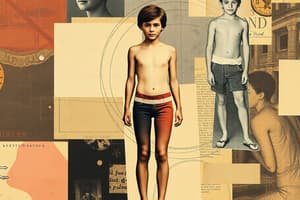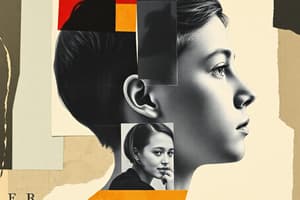Podcast
Questions and Answers
During which life stage does physical efficiency generally reach its peak?
During which life stage does physical efficiency generally reach its peak?
- Middle Age (40-60 years)
- Late Adulthood (60+ years)
- Early Adulthood (20-30 years) (correct)
- Adolescence (14-18 years)
According to the provided content, what contributes significantly to physical changes at the start of adolescence?
According to the provided content, what contributes significantly to physical changes at the start of adolescence?
- Peer pressure
- Decreased physical activity
- Secretion of various hormones (correct)
- Changes in diet
Which of the following is most closely associated with body image?
Which of the following is most closely associated with body image?
- How individuals perceive, think, and feel about their body (correct)
- Genetic predispositions towards certain body types
- An individual's actual physical health
- The objective measurements of one's body
In the context of physical growth and development, what does 'heredity' primarily encompass?
In the context of physical growth and development, what does 'heredity' primarily encompass?
Which factors are said to affect an individual's physical development?
Which factors are said to affect an individual's physical development?
According to the theory of physiognomy, what can be related to a person's character or personality?
According to the theory of physiognomy, what can be related to a person's character or personality?
In Hippocrates' theory, what is the basis for influencing a person's personality, temperament, and well-being?
In Hippocrates' theory, what is the basis for influencing a person's personality, temperament, and well-being?
What characteristic is most associated with individuals having an 'ectomorphic' body type, according to William Sheldon's theory?
What characteristic is most associated with individuals having an 'ectomorphic' body type, according to William Sheldon's theory?
According to Jean Haner, what facial shape is associated with individuals who are generally hospitable and tactful?
According to Jean Haner, what facial shape is associated with individuals who are generally hospitable and tactful?
What is a primary concern that adolescent girls express regarding their bodies?
What is a primary concern that adolescent girls express regarding their bodies?
What potential psychological effect is associated with higher body dissatisfaction in girls?
What potential psychological effect is associated with higher body dissatisfaction in girls?
What is the key characteristic of anorexia nervosa as described in the passage?
What is the key characteristic of anorexia nervosa as described in the passage?
What aspect of physical appearance is generally considered important across cultures?
What aspect of physical appearance is generally considered important across cultures?
How do advertisements and magazines influence perceptions of beauty?
How do advertisements and magazines influence perceptions of beauty?
What is one of the traditional reasons for tattooing and piercing across cultures?
What is one of the traditional reasons for tattooing and piercing across cultures?
Which activity is a recommendation to improve body image and inner self?
Which activity is a recommendation to improve body image and inner self?
The term 'life span,' as defined in the text, refers to:
The term 'life span,' as defined in the text, refers to:
According to the information presented, what is one potential drawback of body modification procedures like cosmetic surgery?
According to the information presented, what is one potential drawback of body modification procedures like cosmetic surgery?
What is a key difference in body image concerns between adolescent boys and girls, as suggested in the material?
What is a key difference in body image concerns between adolescent boys and girls, as suggested in the material?
Why is physical appearance not enough to understand a person?
Why is physical appearance not enough to understand a person?
Flashcards
What is a life span?
What is a life span?
Development from conception to death
What is the Prenatal stage?
What is the Prenatal stage?
Fertilization to birth
What is the Infancy stage?
What is the Infancy stage?
Birth to 2 weeks of life
What is the Babyhood stage?
What is the Babyhood stage?
Signup and view all the flashcards
What is early childhood?
What is early childhood?
Signup and view all the flashcards
What is late childhood?
What is late childhood?
Signup and view all the flashcards
What is Puberty?
What is Puberty?
Signup and view all the flashcards
What is Adolescence?
What is Adolescence?
Signup and view all the flashcards
What is Early adulthood?
What is Early adulthood?
Signup and view all the flashcards
What is Middle adulthood?
What is Middle adulthood?
Signup and view all the flashcards
What is Late adulthood/senescence?
What is Late adulthood/senescence?
Signup and view all the flashcards
What is heredity?
What is heredity?
Signup and view all the flashcards
What is environment?
What is environment?
Signup and view all the flashcards
Hippocrates' Theory highlights?
Hippocrates' Theory highlights?
Signup and view all the flashcards
What is the Sanguine type?
What is the Sanguine type?
Signup and view all the flashcards
What is the Melancholic type?
What is the Melancholic type?
Signup and view all the flashcards
What is the Choleric type?
What is the Choleric type?
Signup and view all the flashcards
What is the Phlegmatic type?
What is the Phlegmatic type?
Signup and view all the flashcards
What is Body image?
What is Body image?
Signup and view all the flashcards
What is Anorexia?
What is Anorexia?
Signup and view all the flashcards
Study Notes
Physical Self Overview
- Understanding the physical self involves analyzing the lifespan and physical development.
- Physical changes during adolescence are largely from hormone secretion, affecting how adolescents perceive themselves.
- Girls generally express more dissatisfaction with their physical appearance and body image than boys.
- Self-consciousness and dissatisfaction peak for girls between 13 and 15 years old.
Defining the Physical Self
- The physical self refers to the body's physical extremities and internal organs working together.
- Body functions change with aging, performing least efficiently during infancy and old age.
- Physical efficiency peaks in early adulthood, between ages 20 and 30.
- Physical development in childhood is slower compared to babyhood.
- Adolescence begins with puberty, marked by rapid physical changes and reproductive system maturation.
- Everyone goes through developmental stages across their lifespan, which is from conception to death.
Stages in the Lifespan
- Prenatal: Fertilization to birth
- Infancy: Birth to 2 weeks of life
- Babyhood: 2 weeks of life to 2nd year
- Early Childhood: 2 to 6 years old
- Late Childhood: 6 to 10 or 12 years old
- Puberty: 10 or 12 to 14 years old
- Adolescence: 14 to 18 years old
- Early Adulthood: 18 to 40 years old
- Middle Adulthood: 40 to 60 years old
- Late Adulthood/Senescence: 60 years old to death
Impact of Puberty on Behavior
- Physical changes during puberty affect behavior, causing uncertainty about abilities, interests, and self-perception.
- Body changes can lead to dissatisfaction and an unfavorable self-concept.
Factors Affecting Physical Growth
- Physical growth and development are influenced by heredity and environment.
- Heredity is the inheritance of traits from parents.
- Environment includes life-long exposures and experiences, like diet, nutrition, and diseases.
- Sex and physical traits are determined by chromosome and gene combinations during fertilization.
- Chromosomes are threadlike tissues carrying genes, usually in pairs.
- Humans have 23 pairs of chromosomes: 22 pairs of autosomes (trait chromosomes) and 1 pair of gonosomes (sex chromosomes).
- Offspring sex is determined by the pairing of sex chromosomes (23rd pair) from parents.
- Genes are the basic carriers of hereditary traits, classified as dominant (strong) or recessive (weak).
Theories of Physical Self
- Physiognomy: Physical characteristics relate to personality.
- Ancient Chinese face reading: The face reflects who we are and life's impact using the Five Element theory.
- Five Element Theory: Water, wood, fire, earth, and metal are archetypes correlated to seasons, colors, shapes, sounds, facial features, body types, body organs, and behavior.
- Face readers observe facial features and markings to understand mental, emotional, and physical makeup.
- Hippocrates' theory: Body fluid prominence influences personality and well-being.
- Sanguine: Prominence of red bile; impulsive, cheerful, happy, optimistic.
- Melancholic: Prominence of black bile; depressed and pessimistic.
- Choleric: Prominence of yellow bile; easily angry, jumpy, temperamental.
- Phlegmatic: Excess phlegm; sluggish, dull, slow.
- William Sheldon's Body-Type Theory (1940s): Based on physical characteristics.
- Endomorphic: Soft and plump; easygoing and sociable.
- Mesomorphic: Strong muscular body; energetic, adventurous, assertive, courageous, competitive, dominant.
- Ectomorphic: Tall and thin; restrained, quiet, introverted, artistic.
- Jean Haner's Face Shape Theory (The Wisdom of Your Face):
- Oval-shaped faces: Hospitable and tactful.
- Round-shaped faces: Friendly, kindhearted, selfless.
- Square faces: Witty, analytical, great leaders.
- Heart-shaped faces: Patient and intuitive.
- Long-shaped faces: Perfectionistic and aggressive.
- Triangle-shaped faces: Creative, artistic, sensitive, determined.
- Diamond faces: Detail-oriented and like control.
- Full, thick eyebrows: Confident, assertive, goal-oriented.
- Large, defined jaws: Strong values and firm beliefs.
- Squier and Mew (1981): Long, angular faces tend to be responsive, assertive, and genuine. Short, square faces tend to be restrained, conforming, and shrewd.
Body Image
- Body image is how individuals perceive, think, and feel about their body and physical appearance.
- Appearance includes height, weight, skin color, clothes, and hairstyle.
- Physical appearance communicates one’s persona to others.
- Puberty timing influences how adolescents feel about themselves.
- Body image relates to self-esteem, affecting physical and psychological well-being.
- Adolescents worry about their bodies, with girls more concerned about appearance and body image than boys, worrying about conforming to beauty standards.
Sociocultural Factors
- Adolescent reactions to physical appearance depend on sociocultural factors.
- Peer, parent, and media emphasis on ideal body types leads to body dissatisfaction.
- Bullying and peer pressure correlate with greater body dissatisfaction.
- Media promotes a slim ideal, causing comparison and potential changes through cosmetic surgery, dieting, or exercise.
- Excessive concern about thinness results in body dissatisfaction, depression, low self-esteem, and eating disorders.
- Anorexia: Refusal to eat due to fear of weight gain, potentially leading to starvation and death, mainly affecting females aged 12-40.
- Bulimia Nervosa: Purging after binging.
Importance of Beauty
- Conceptions of beauty vary across cultures and time.
- Egyptian art: Slim with high waist, narrow hips, long black hair.
- Renaissance: Full figure, rounded hips.
- Medieval Africa: Chubby, fat, plump.
- Malaysia, Philippines, Indonesia: Flat noses.
- Clean skin, shiny hair, well-proportioned bodies, and symmetrical faces are generally considered beautiful.
- Beauty indicates youth, health, good genes, and fertility.
- Media emphasizes physical attractiveness, influencing perceptions of beauty.
- Media-set beauty standards can be unrealistic, leading to dissatisfaction.
Body Modification
- Body modification alters physical appearance:
- Tattooing: Injecting ink for designs.
- Body piercing: Wearing jewelry through piercings.
- Cosmetic surgery: Restoring, reconstructing, or altering body parts (breast enhancement, nose lift, liposuction, Botox).
- Body modification involves health risks like infections, allergies, and complications.
Impact of Attractiveness
- Beauty is important across societies.
- Attractive individuals are often treated more favorably.
- Attractive people are perceived as good, happier, smarter, and better.
- Adolescents feel self-conscious, seeking appearance improvements.
- Beauty standards vary across cultures.
Improving Body Image
- Ways to improve body image and inner self:
- Smile a lot.
- Take good care of your health.
- Live a well-balanced life.
- Dress well and be neat.
- Reflect alone.
- Be creative and do new things.
- Develop a wholesome attitude towards sex.
- Avoid temptations.
- Respect individuality.
- Make friends.
- Face your fears.
- Be independent.
- Accept things as they are.
- Ask and listen.
- Think positive thoughts.
- Pray.
- Count your blessings.
- Be thankful.
Studying That Suits You
Use AI to generate personalized quizzes and flashcards to suit your learning preferences.




